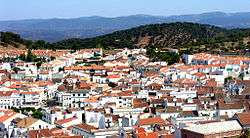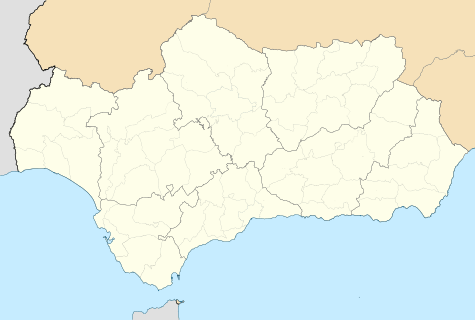Aracena
| Aracena | |||
|---|---|---|---|
 | |||
| |||
 Aracena Location in Andalusia | |||
| Coordinates: ES 37°53′28″N 6°33′40″W / 37.89111°N 6.56111°W | |||
| Country |
| ||
| Autonomous community |
| ||
| Province | Huelva | ||
| Comarca | Sierra de Huelva | ||
| Government | |||
| • Mayor | Manuel Guerra González | ||
| Area | |||
| • Total | 184 km2 (71 sq mi) | ||
| Population (2014) | |||
| • Total | 7,859 | ||
| • Density | 43/km2 (110/sq mi) | ||
| Time zone | CET (UTC+1) | ||
| • Summer (DST) | CEST (UTC+2) | ||
| Website | Official website | ||
Aracena (Spanish pronunciation: [aɾaˈθena]) is a town and municipality located in the province of Huelva, south-western Spain. As of 2012, the city has a population of 7,814 inhabitants. The town gives its name to the Sierra de Aracena, part of the Sierra Morena system.
Aracena is the largest town in the Parque Natural Sierra de Aracena y Picos de Aroche. In 2006, Aracena was named a Tourist Municipality of Andalucía and became the first town in the province of Huelva to achieve this status.
Main sights
Aracena Castle
Prominent attractions in the town include Aracena Castle and the Priory Church, together known as the Castillo-Iglesia de Nuestra Señora de los Dolores, built between the 13th and 15th centuries over the ruins of an earlier castle. The oldest sections are of late Gothic-Mudéjar style.
Aracena Castle was erected in the thirteenth century, during the Islamic period, and was itself built on the site of an ancient Moorish castle. The walled enclosure was partitioned inside, with the tower of homage, or castle keep, defending the barrier that divided its interior. The population of Aracena settled around this structure, giving rise to the current urban landscape. During the late Middle and Modern Ages, Aracena continued growing from the Cerro del Castillo [Castle Hill] into the valley, first as unattached land dependent on Seville and later, in the seventeenth century, as a feudal estate under the jurisdiction of the Count-Duke of Olivares. Still later, it was under the Count of Altamira, who carried the title of Prince of Aracena.
The fortress consists of the alcazaba, or citadel, with its watch tower, cistern and walls; these are flanked by other towers, as well as a fence line that, in its interior, once accommodated medieval living quarters.
Prioral Church
When Aracena was ceded by the Crown of Castile to the Knights Templar, that Order authorized the raising of the current Moorish-style church, noted for the glazed clay sculptures of Pedro Vazquez and which takes its name from the local patron saint, Nuestra Señora del Mayor Dolor [Our Lady of the Greatest Suffering].
The church is emblematic of Aracena and is the oldest church in the town. It consists of three naves of equal height with its choir at the feet and a polygonal presbytery to which, on the side of the chapel, there is attached its Mudéjar-style tower.
Also in the town is the church of Santa María de la Asunción, built in 1522.
Groto of the Marvels
Also located in the town is the Gruta de las Maravillas, one of the most spectacular cave systems in Spain. The caves are located below the hill on which stands Aracena Castle. Opened to the public in 1913, it includes a total of 2130 meters of subterranean passages.
Several caverns and lakes are linked by these narrow passages. Coloured lighting adds to the effects of its unusual mineral formations. In the complex is a geological museum. The caves are said to have been found by a boy looking for a lost pig.
Museum
El Museo del Jamón de Aracena (Museum of the Arecena Ham). This exhibit consists of 7 rooms which trace the history, cultures and traditions surrounding the famous Iberian pig.
Gallery
-

Prioral Church of Aracena (frontal view)
-
Church of Santa María de la Asunción.
-

Casino of Aracena.
-
Gruta De Las Maravillas cave.
External links
- Official Web of Aracena in Internet - The Official Web of Aracena in Internet
- Aracena - Sistema de Información Multiterritorial de Andalucía
- (Spanish) - Natural Park Sierra de Aracena and Picos de Aroche
- http://www.discoverhuelva.com/town/aracena-0

